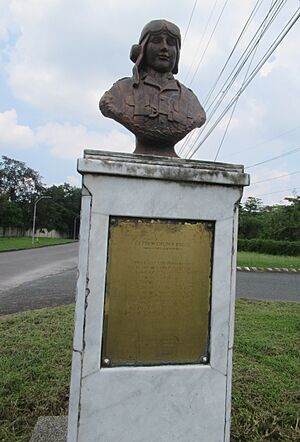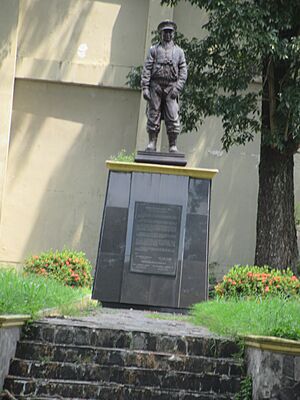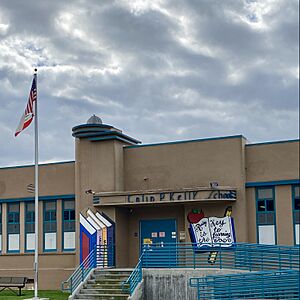Colin Kelly facts for kids
Quick facts for kids
Colin Kelly
|
|
|---|---|

Kelly, painted in 1942
|
|
| Birth name | Colin Purdie Kelly Jr. |
| Born | July 11, 1915 Madison, Florida, U.S. |
| Died | December 10, 1941 (aged 26) Clark Field, Pampanga, Philippines |
| Buried |
Oak Ridge Cemetery, Madison, Florida
|
| Allegiance | United States |
| Service/ |
United States Army Air Corps |
| Years of service | 1937–1941 |
| Rank | Captain |
| Unit | 14th Bombardment Squadron, 19th Bombardment Group |
| Battles/wars | World War II |
| Awards | Distinguished Service Cross Distinguished Flying Cross |
| Alma mater | West Point Class of 1937 |
Colin Purdie Kelly Jr. (born July 11, 1915 – died December 10, 1941) was a brave pilot during World War II. He flew a large bomber called a Boeing B-17 Flying Fortress. He became famous for his courage in the very first days after the Pearl Harbor attack. He is remembered as one of the first American heroes of the war. He told his crew to jump out of their plane when it was badly damaged. He stayed behind to try and keep the plane steady. This allowed his crew to escape before the plane exploded, but he died. His B-17 was the first American B-17 bomber shot down in a fight during the war.
Contents
Who Was Colin Kelly?
Colin Kelly was born in Madison, Florida in 1915. He finished high school there in 1932. After that, he went to West Point, a famous military academy, in 1933. He graduated in 1937 and joined a B-17 bomber group. He was the first Army officer to fly the Boeing Flying Fortress in the Far East.
What Happened on December 10, 1941?
On December 10, 1941, Captain Kelly was flying a B-17C Flying Fortress bomber. He was part of the 14th Bombardment Squadron. His plane took off from Clark Field in the Philippines. It was flying alone to look for a Japanese aircraft carrier.
His plane was not fully fueled or armed because a Japanese air raid was expected. It only carried three 600-pound bombs. While flying, Kelly and his crew saw a group of Japanese ships. They thought they saw a large battleship. Since they couldn't find the aircraft carrier, Kelly decided to attack the ships they had seen.
The Attack on Japanese Ships
Kelly flew his plane over the ships twice at 20,000 feet. His bombardier, MSgt Meyer Levin, got ready to drop the bombs. On the third pass, Levin dropped all three bombs. They hit near a Japanese light cruiser named Natori. An escorting destroyer, Harukaze, was also damaged.
A report from that time said:
- The ship was about 4 miles from shore.
- The bombs were dropped quickly.
- The first bomb landed short, the next alongside, and the third hit the middle of the ship.
- A lot of smoke came from where the bomb hit.
- The ship started moving strangely and headed towards shore.
- It left a long trail of oil behind it.
The Final Moments
On its way back, Kelly's bomber was attacked by Japanese A6M Zero fighter planes. These planes were patrolling over Vigan. They attacked the B-17 again and again.
Kelly bravely ordered his crew to jump out of the plane. Even though the plane was on fire, Kelly stayed at the controls. He tried to keep the plane flying straight and level. This gave his crew a chance to escape.
- Staff Sergeant James E. Halkyard, Private First Class Willard L. Money, and Private Robert E. Altman got out from the back of the plane.
- The navigator, Second Lieutenant Joe M. Bean, and the bombardier, Sergeant Levin, escaped through the front hatch.
- As co-pilot Lieutenant Donald Robins tried to open his hatch, the plane exploded. Robins was thrown clear and was able to open his parachute.
The B-17C crashed about 3 miles east of Clark Field. Captain Kelly and Technical Sergeant William J. Delehanty were found at the crash site. Kelly's parachute was still unopened, showing he stayed with the plane until the very end.
Early reports mistakenly said the ship Kelly attacked was sunk. While it was hit and damaged, it did not sink.
Honors and Legacy
Colin Kelly was given the Distinguished Service Cross after his death. This award was for his "extraordinary heroism" and "selfless bravery." He had also received the Distinguished Flying Cross earlier.
The United States Junior Chamber of Commerce gave Kelly its 1941 distinguished service award. This award is given each year to a young man who has done the "most significant" service for the country.
President Franklin D. Roosevelt wrote a letter in 1941. He asked for Kelly's infant son to be appointed to West Point when he grew up. Colin P. Kelly III did go to West Point, graduating in 1963. He earned his spot by taking the exams, not through the special nomination.
Many places have been named in Colin Kelly's honor:
- Colin P. Kelly Jr. Street in San Francisco, California. It was named in 1942 and used to be called Japan Street.
- Colin Kelly Dr. in Dayton, Ohio, near Wright Patterson Air Force Base.
- Colin Kelly Drive in Forest Acres, South Carolina.
- Colin Kelly Street in Cranford, New Jersey.
- Colin Kelly Rd in South Portland, Maine.
He is also mentioned in the patriotic song There's a Star-Spangled Banner Waving Somewhere. The song places him alongside other American heroes like Abraham Lincoln and George Washington.
The "Four Freedoms Monument" and Colin Kelly Highway in Madison, Florida, are also dedicated to him.
Colin Kelly Middle School in Eugene, Oregon, was named after him in 1945. The students wanted to honor an "ordinary Joe" instead of a famous military or political person. The school's original nickname was "Bombers," but it was changed to "Pilots" in 2009. The school is now called "Kelly Middle School."
Colin P. Kelly Elementary School in Compton, California, is also named for him. Its mascot is a plane, and its motto is "soaring to academic excellence."
The Colin Kelly Heights public housing area in Tonawanda, New York, was completed in 1943 and named after him.
Interestingly, Colin Powell adopted the pronunciation of his first name, /ˈkoʊlɪn/, because friends who admired Colin Kelly began saying Powell's name the same way.




